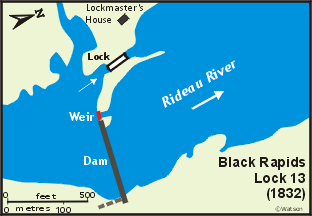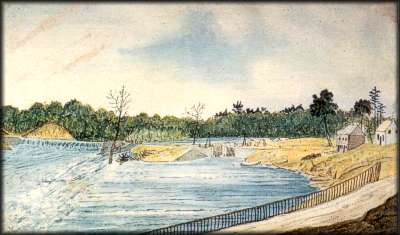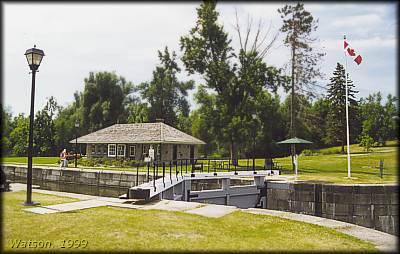Black Rapids Lock 13
| location map | lockstation information |
The Setting
The original Black Rapids were 2,945 feet (900 m) in length, descending in that distance 4 feet 6 inches (1.4 m), with a mean width of 275 feet (84 m). The water at the foot of the rapids, where the dam was proposed, was 2 feet (0.6 m) deep. Between Black Rapids and Long Island, the channel was clear except for two small sets of rapids, Goodwood Rapids and Wicked Rapids (also known as Jock Rapids).
The Plan
The tender for this site stated that the contractor was to "construct a Dam across the Rideau River 280 feet wide, perpendicular height 10 feet & a Lock of 10 feet lift; this Dam is to throw back the Water & thereby form a sheet of still water 5 miles long, which completes the Canal to the foot of Long Island Rapids." The dam at Hogs Back was to raise the water at the site of the lock at Black Rapids by 6 feet (1.8 m).
An interesting note is that some thought the Jock River (originally known as Goodwood River or River Jocque) could be made into a navigable waterway to connect Richmond with the Rideau. The outlet for the Jock is just downstream of the locks at Long Island. The dam at Black Rapids raised the level of the lower Jock by a few feet, but it still would have required extensive work and several locks to make it navigable. The plan for this never got past the conceptual stage.
Building the Locks
The contract was awarded to Andrew White and Thomas Phillips, a "respectable mason at Montreal." Stone for the lock and dam was quarried locally at the foot of the rapids.
 Similar to many lockstations, the dam was to cause more problems than the lock. The sandy eastern bank of the river was found to be a problem. The stone keywork had be extended into the bank for 60 feet (18 m) and a retaining wall built in front to prevent water from finding its way around the dam. The dam itself was a flat wooden structure, filled with stone, sheeted with thick planks on the front and top, with stone keywork on the back. Similar to many lockstations, the dam was to cause more problems than the lock. The sandy eastern bank of the river was found to be a problem. The stone keywork had be extended into the bank for 60 feet (18 m) and a retaining wall built in front to prevent water from finding its way around the dam. The dam itself was a flat wooden structure, filled with stone, sheeted with thick planks on the front and top, with stone keywork on the back.
When the dam was completed to its planned 10 foot (3.0 m) height, it was found that with the river flowing over it in spring flood, erosion of the bedrock on the downstream side of the dam threatened to undermine it. The dam was raised to 12 feet (3.7 m) in height to allow most of the water to flow through a waste weir, constructed between the dam and the lock. Colonel By in his 1830 report stated: "Having observed that the spring flood flowing over the Dam, had a great effect upon the bed of the River; immediately in rear of the same by tearing up the strata of Rock, I considered it indispensable necessary to provide for the safety of the Dam, and in consequence have built a Waste Weir sufficiently wide to allow a large portion of the water of the River to pass through it during the Spring floods, and so constructed, as that the water can be drawn down below the level of the Upper Sill of the Lock, to provide for repairing the Works when required. The Weir completely answered the purpose desired in the Spring of 1830, very little water passing over the Dam."
A single lock with a lift of 9.2 feet (2.8 m) was built on the west bank of the river. The bedrock was deemed to be of sufficient quality that it was left bare as the floor of the lock.
To make the Wicked Rapids, between Black Rapids and Long Island navigable, some rock excavation and boulder removal was done.
 |
Lock, Dam &c at Black Rapids, Men Pumping Water out of Lock, to hang the Gates &c &c; September, 1830
Thomas Burrowes, watercolour, Archives of Ontario
This painting shows crews lifting the lower lock gates into place using block and tackle mechanisms. To the left is the waste weir and overflow dam. The stone locksmaster’s house is visible on the right as is a log bunkhouse. In the foreground is the road leading to the Ottawa Locks. |
Through the Years
The dam at Black Rapids was particularly vulnerable to damage from ice and flood wood. Several repairs had to be made to fix this damage. In 1862 a new flat pressure dam was built just downstream of the existing dam. Ice damage force repairs in 1900 with much more extensive repairs in 1906 and a rebuild in 1909. In 1909 the Rideau experienced the greatest flooding recorded up to that time and it washed away much of the sandy bank at the east end of the dam. The dam itself was not damaged, but due to the east bank erosion issue the dam was extended by another 100 feet with wing walls added. In 1949-1954, the old timber dam was reconstructed in concrete.
The waste weir required several repairs over the years and was finally rebuilt with concrete in 1925.
The lock fared better than the dam, only requiring periodic maintenance to repair its ageing masonry. In 1928, the lock chamber walls were rebuilt with concrete blocks.
In 1829, a two-storey non-defensible (no rifle slits) stone house was built for the lockmaster. It was torn down in 1914 and a new frame house was built on the old foundation walls. In the late 1960s, that frame house was removed and a modern (designed in 1967) lockstation office was built.
The lock was electrified (electric/hydraulic cylinders to open and close the lock gates) in 1969.
 |
Black Rapids
photo by: Ken Watson, 1999
A neat looking lockstation building and verdant lawns characterize this typical Rideau lockstation. This type of modern lockstation office was designed in 1967 to be conformable with Rideau landscapes and was built at several lockstations to replace the old lockmaster houses. |
The Lockmasters to 2000
The first lockmaster was William Newman, proposed by By in 1831. By 1840, the lockmaster was William Broad who was discharged in April 1840 for drunkenness. He was replaced by Thomas Newman, who served until April 1843 when he exchanged places with Lockmaster Buck at Clowes. Buck didn't seem to last very long and after a couple of replacements, James Pilson took over in 1844. In March 1847 he was transferred to Hartwells and was replaced by Sergeant R. Thynne. He was succeeded by James Davy in about 1857, and in 1866 Davey was succeeded by Robert Hardy, who served as lockmaster until his retirement in 1907 at age 73. Hardy was succeeded by Allan P. McDonnel who died in November 1911 at age 61. George Armstrong was appointed lockmaster in December 1911 and served until his resignation in 1918. He was followed by G.H. Balcomb in 1918; Thomas Scott from 1919 to 1931; H.S.G. Blacombe from 1932 to 1945; Kennedy from 1946 to 1953; Bernard (Bud) Trickett from 1954 to 1977; Andy St. Amour from 1978 to 1982; several acting lockmasters (Jack Dion, Lucien Gauthier, Vince Leduc) from 1983 to 1985; George Buys from 1986 to 1988; Jim Gibbs from 1989 to 1995 and George Buys from 1995 to 2000.
|